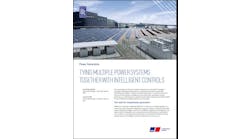Camden, New Jersey officials explain their microgrid strategy to avoid the kind of power outages experienced in Texas last month. Jeffery Nash, a Camden County commissioner, and City Councilwoman Shaneka Boucher offer an update on the project’s status.
Last month, we watched in horror as Americans in Texas suffered one of the worst energy crises outside of a natural disaster in recent memory. When an unprecedented cold streak gripped the state, residents there found their energy infrastructure woefully inadequate, and millions were left without power and water for days or even weeks.
For those of us in public service, this was yet another reminder of the importance of proactive preparations that can protect our communities in times of emergencies.
.
It was for this very reason that the Camden County Commissioner Board and the City of Camden began working on a proposal for a “microgrid” in Camden several years ago. A microgrid is separate from the main electrical grid and can therefore supply energy to public services such as the Camden County Municipal Utilities Authority (CCMUA) and critical commercial loads like hospitals when the main grid fails.
A past feasibility study supported the concept of a “sustainability loop” between the CCMUA and Covanta Energy Recovery Center, which would [source] locally generated energy and establish a microgrid that could separate from the main electrical grid during an outage.
Since then, the Board of Commissioners and the CCMUA, in partnership with Compass Energy Platform, have worked to further develop the proposal. Last week, in a letter regarding its plans, Compass announced that it had determined it would be able to develop a sufficient number of local generation assets, such as solar, anaerobic digestion and battery storage, to power the microgrid without relying on Covanta as an energy source.
This is exciting news because it means that this innovative venture in resiliency can be advanced using even cleaner renewable energy sources. This will reduce the city’s carbon footprint, improve air quality and increase the presence of renewable energy in Camden.
As we have said in the past, this kind of project has never been done in the state of New Jersey and would represent a first-of-its-kind technological achievement, bringing enormous benefits to Camden City and Camden County. The clean, cheaper and resilient power that the microgrid will be able to offer its customers should help businesses with power quality needs, having a direct impact on the local economy and availability of jobs.
Most importantly, the microgrid will help protect the citizens of Camden from power outages in the case of storms, flooding or other emergencies.
The need for emergency preparation of all kinds has never been clearer. While our region has been largely spared from the worst effects of recent natural disasters, the events in Texas last month underscore how fragile the systems we rely on really are, and how dramatic the effects can be of failing to prepare well in advance.
By investing in infrastructure improvements, like the microgrid, we will be prepared to mitigate the impacts of major storms and provide our residents access to critical public health and safety services during emergencies. With the recent adjustments provided by Compass, we can accomplish these critical public safety goals without compromising the ecological and public health of our community.
Jeffery Nash is a commissioner on the Camden County Board of Commissioners and Shaneka Boucher is a City Councilwoman, representing Ward 1.







